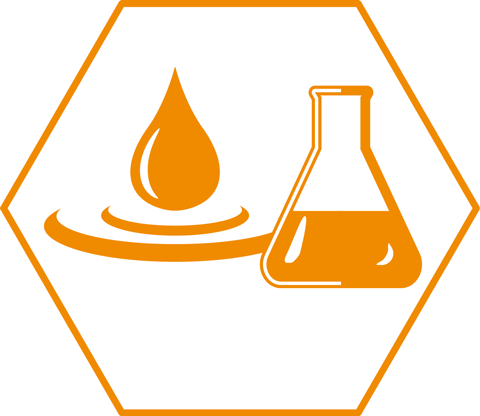Physical and technical basics / Fluids
The central element of hydraulics is the hydraulic fluid. Hydraulic fluids are very diverse in their properties and behaviour. Both the properties and the behaviour are the focus of this research field. The investigation methods are very diverse and are often adapted from physics, analysis technology or (flow) measurement technology to the special features of fluid-mechatronic applications. The air solubility of fluids can be investigated using analytical methods such as a tensile and shear test. In experiments as well as in numerical flow simulations, for example, steam cavitation and its behaviour as well as the intensity of the resulting erosion can be determined. Corresponding analysis and measurement methods as well as sensor technology are also being further developed. In addition, a fluid laboratory is equipped with analytical instruments such as viscometers, refractometers, measuring microscopes, temperature control systems, precision scales, pycnometers, an oxygen sensor and many more.
Selected Projects
Objects of investigation
- cavitation and cavitation erosion in typical hydraulic flow geometries
- vapour cavitation (evaporation / condensation) and
gas cavitation (de- and absorption of air) - determination of material data and characteristic values of different hydraulic fluids
- particle transport via sealing elements
Main research areas / questions
- analysis of the properties and behaviour of hydraulic fluids
- fundamental studies on cavitation and cavitation erosion
- separation and detailed analysis of steam and gas cavitation
- parameterization, validation and development of numerical flow models for cavitation calculation and erosion prediction
- (further) development of measurement methods
Methods
- striae and shadow methods, Particle Image Velocimetry (PIV) and Laser induced fluorescence (LIF)
- tensile and shear tests to investigate the absorption and desorption behaviour
- cavitation test rig with exchangeable erosion samples, oil conditioning and analysis sections for the volume content of free gases
- calibration device for volume flow sensors
- numerical flow calculations (CFD)
Cavitation
- Parametrierung of cavitation models to expand the operating range of oil-hydraulic components and systems
- Extension of the operating conditions of HFC-components, please continue reading ...
-
Delivery behaviour and energy efficiency of dosing pumps in vehicles, please continue reading ...
- Noise and wear resulting from cavitation in oil-hydraulic components, please continue reading ...
- Cavitation and cavitation erosion in poppet valves, please continue reading ...
- Cavitation erosion of various hydraulic fluids and their mixing components, please continue reading ...
Fluid properties
- Air dissolution and air release in Liquids, please continue reading ...
Measurement technology
- Development of a multifunctional ultrasonic flow meter for application in hydraulics, please continue reading ...
Dirt ingress behavior
- Analysis of the dirt ingress behavior of sealing elements, please continue reading ...

